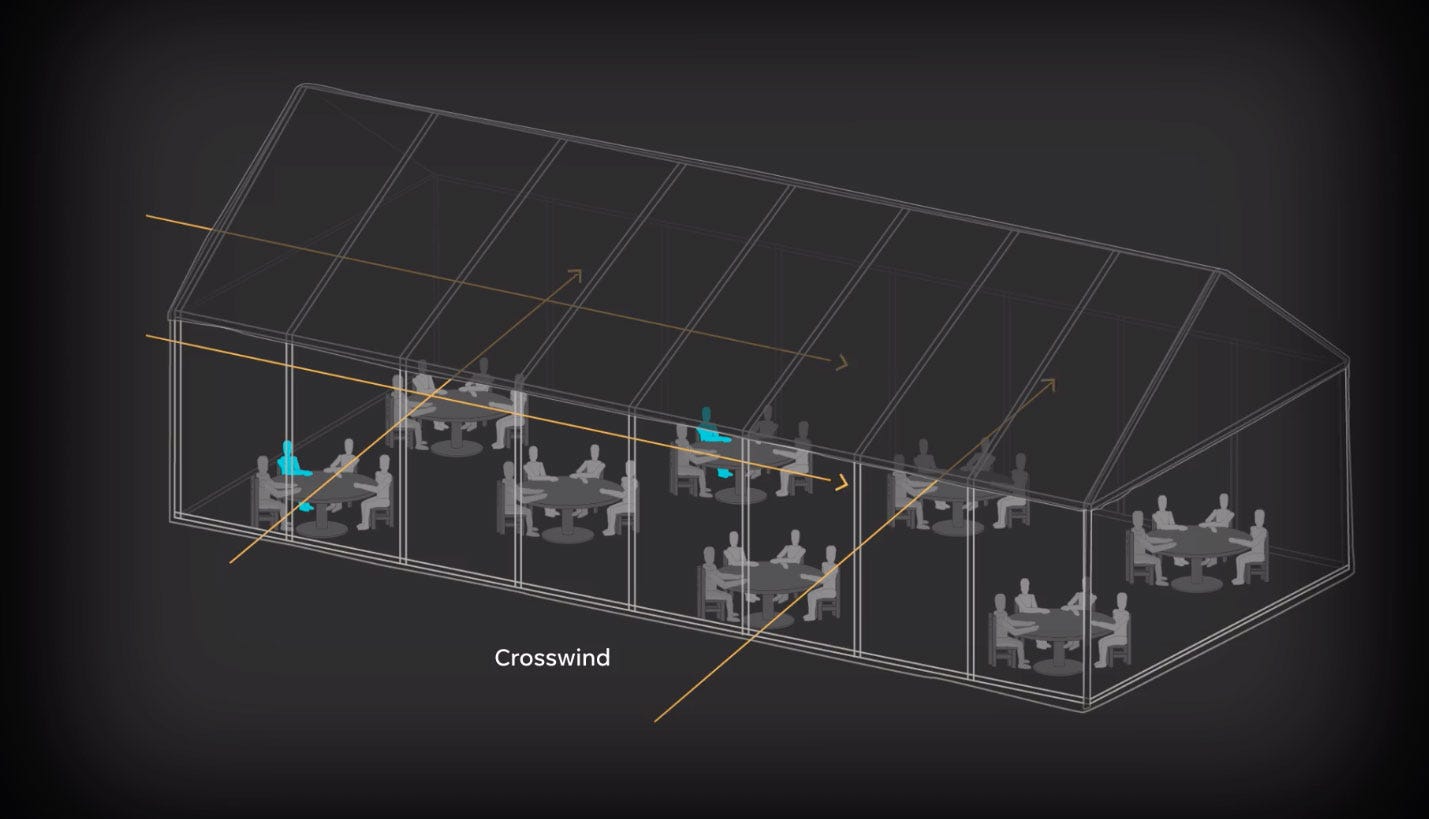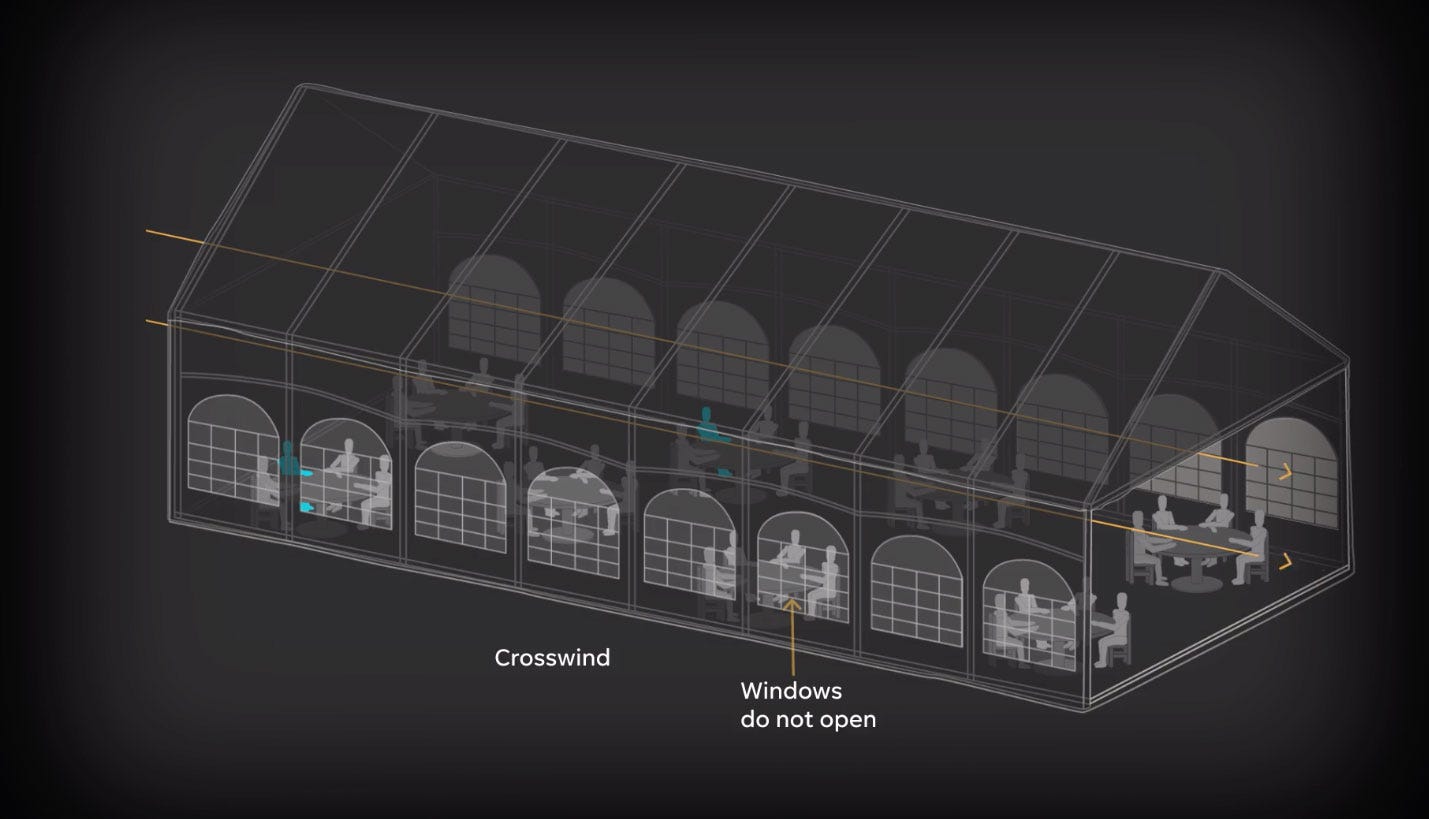Some structures may be relatively safe, others could be worse, trapping aerosols inside
COVID-19 ushered in a new era of outdoor dining as struggling restaurants tried to stay in business while minimizing guests’ chances of infection.
Yet, creating temporary dining rooms in parking lots or sidewalks outside doesn’t always mean it’s safer. In some situations this fall and winter, it possibly increased diners’ odds of infection.
“A structure located outside can be just as hazardous to its occupants, and perhaps more so, if it is not designed to properly control infectious aerosol concentration,” says William P. Bahnfleth, an engineer and a professor of architectural engineering at Penn State.
Spring could usher in good news, though, for those longing for a safe night out free of “infectious aerosol concentration,” the number of infected tiny particles floating in any room.
So what makes a dining environment safe? USA TODAY worked with Qingyan Chen, professor of Mechanical Engineering at Purdue University, to simulate how the virus can spread in a sample structure to help you make more informed decisions.
Not all outdoor dining structures and outdoor seating are created equal
It measures 23.6 feet long by 8.2 feet tall by 8.7 feet wide.
For the following simulation, we assume two air changes per hour based on gaps in the makeshift plastic windows and air leakage around the joints and door.
The wind speed is 0.5 meters per second which is considered to be light air on the Beaufort scale. With windows closed, the air would go around the structure and not through it.
Simulation 1: With all windows in place, aerosols from an infected person who is eating and talking travel throughout the structure. For clarity, the simulation only shows 10% of the aerosols, which are not to scale, that the diner would exhale in 10 minutes.
Simulation 2: For this simulation the front, left and right windows are removed.
The wind speed remains at 0.5 meters per second, but it now passes through the structure.
Viral aerosols are now less concentrated in a 10-minute period.
The volume of aerosols is cut by 4.4 times when the windows are removed. Once the infected person leaves, it would take less than two minutes for the infected aerosols to completely disperse.
“The reduction in particle concentration, in simulation 2 would be similar to a conversation with an infected person where both are wearing a surgical masks,” says Chen. “Simulation 1 is similar to a conversation with an infected person without wearing masks.”
This outdoor wooden structure has no mechanical ventilation. It measures 23.6 feet long, 8.7 feet wide by 8.2 feet tall. The wind speed is 0.5 meters per second which is consider to be light air on the Beaufort scale. With windows closed, the air would go around the structure and not through it.
For this simulation, we assume two air changes per hour based on gaps in the makeshift plastic windows and air leakage around the door.
In the below simulation, aerosols from an infected person who is eating and talking travel throughout the structure. For clarity the simulation only shows 10% of the aerosols, which are not to scale, that the diner would exhale in 10 minutes.
For Simulation 2, the wind speed remains at 0.5 meters per second, but it now passes through the structure. Viral aerosols are now less concentrated in a 10-minute period:
The volume of aerosols is cut by 4.4 times when the windows are removed. Once the infected person leaves, it would take less than two minutes for the infected aerosols to completely disperse.
“The reduction in particle concentration, in simulation 2 would be similar to a conversation with an infected person where both are wearing a surgical masks,” says Chen. "Simulation 1 is similar to a conversation with an infected person without wearing masks."
“When we normally define ‘outdoors,’ it means that the air can flow through freely,” says Chen. “With windows this structure could be a perfect recipe for infection.
“If there is wind, (a structure) without side walls would be much better than one without a roof,” Chen said. Because aerosols tend to rise, “if there is no wind, a structure without a roof would be better than one without side walls.”
Professor of Civil and Environmental Engineering at Virginia Tech Linsey Marr suggests these structures can give patrons a false sense of security: “You think you’re outdoors but once you make your structure like an indoor one, you’re not really outdoors anymore.”
Decisions on whether to open or close restaurants rest with state and local officials, but a task force of ventilation experts recently released recommendations for outdoor air rates, filter types and time between occupancies. “Guidance that applies to permanent structures must be applied appropriately to these temporary ones, too,” says Bahnfleth, chair of the Epidemic Task Force with the American Society of Heating, Refrigerating and Air-Conditioning Engineers (ASHRAE).
Some state agencies such as the California’s Department of Public Health provide guidelines for outdoor ventilation. The CDPH considers “outdoor” facilities where less than half of the shelter’s walls are adjacent.
The following structures do not contain mathematical simulations but Chen and Marr offer some guidance on airflow and possible exposure considerations when dining:
Outdoor tent dining
Without walls, crosswinds will likely flush out potentially dangerous aerosols. “We are looking for enhanced removal and dilution of respiratory aerosols – that might contain viruses – by wind, which moves mainly in the horizontal direction,” says Marr.
As you add walls, the airflow is reduced. In this example the windows do not open.
“If the wind is blowing left to right in this situation then it could create enough cross ventilation,” says Chen.
However, “if the wind is blowing front to back then it will go around and not through says,” Chen.
Enclosing the majority of the structure will block most crosswinds but “air leakage will be better than being indoors without mechanical ventilation but much poorer than indoors with mechanical ventilation,” says Chen.
In this outdoor tent-like structure, eight parties are seated more than 6 feet apart and the sides are removed.

Without walls, crosswinds will likely flush out potentially dangerous aerosols. “We are looking for enhanced removal and dilution of respiratory aerosols – that might contain viruses – by wind, which moves mainly in the horizontal direction,” says Marr.
As you add walls, the airflow is reduced. “If the wind is blowing left to right in this situation then it could create enough cross ventilation,” says Chen

However, “if the wind is blowing front to back then it will go around and not through," says Chen.
Enclosing the majority of the structure will block most crosswinds but “air leakage will be better than being indoors without mechanical ventilation but much poorer than indoors with mechanical ventilation,” says Chen.
The height of the structure also matters. “It’s probably better for it to be a little higher to allow for a little more dilution under the roof while the wind carries things away,” says Marr.
Being in a tent without walls isn’t a surefire way to be safe, but it is often safer than being indoors. If you are indoors with little fresh air, aerosols can build up, says Marr. “Being outside eliminates the possibility of recirculation, however if you’re directly downwind from an infected person for a while outdoors, it’s possible you could be exposed to enough virus to make you sick.”
Igloo dining
If you are with an infected person who is not in your household, then the risk is significant.
Since the structure is sealed tightly, virus particles can build up over time.
After a party has left, there needs to be time for the structure air out. “An infected person in the previous party could have filled the tent with viral aerosols,” says Marr.
In addition to wiping down surfaces, Marr recommends opening the vents and door for 15-30 minutes to allow aerosols to deplete.
Igloo style tents can be a safe alternative if used correctly. The safest approach is to limit the party to members of your household, since you are already sharing germs with them. “To protect the waiter and yourself, have the waiter stand at the door and pass things through,” suggests Marr.

If you are with an infected person who is not in your household, then the risk is significant.
Since the structure is sealed tightly, virus particles will build up over time.
After a party has left, there needs to be time for the structure air out. “An infected person in the previous party could have filled the tent with viral aerosols,” says Marr.
In addition to wiping down surfaces, Marr recommends opening the vents and door for 15-30 minutes to allow aerosols to deplete.
“Just imagine that somebody was sitting in there smoking, and you have to go in there after they leave, how long would you want to give it to air out,” says Marr.
Another thing to consider when dining in outdoor structures is temperature. “All things being equal, cold air is worse for transmission because we know that the virus survives better at colder temperatures,” says Marr.
Single-party, greenhouse dining pods have become a popular choice for restaurants because of their size and affordability – some can be found for under $800.
Is it safe to eat in greenhouse dining pods?
Several modified versions feature half-doors that allow the wait staff to converse with guests and deliver food without coming inside the structure.
But like the igloo, there may be some risks. “These could also be more hazardous if you’re with someone outside your household,” says Marr. “Concentrations of respiratory aerosols can get very high in there.” The 6-and-a-half feet tall model is roughly 260 cubic feet of space.
If you're dining with members of your own household however, these structures can also protect you from other patrons.
As with the igloo-style pod, make sure it’s cleaned and aired out for 15-30 minutes between parties, says Marr. Several models have louvered roof panels that open, making them easier to air out.
The 6-foot by 8-foot structures are typically made of aluminum with clear, polycarbonate panels.
Several modified versions feature half-doors that allow the wait staff to converse with guests and deliver food without coming inside the structure.
But like the igloo, there may be some risks. “These could also be more hazardous if you’re with someone outside your household,” says Marr. "Concentrations of respiratory aerosols can get very high in there.” The 6-and-a-half feet tall model is roughly 260 cubic feet of space.
If you're dining with members of your own household, however these structures can also protect you from other patrons.
As with the igloo-style pod, make sure it’s cleaned and aired out for 15-30 minutes between parties, says Marr. Several models have louvered roof panels that open, making them easier to air out.
“In all cases, ideally you want to have at least two openings on opposite sides so the air can flush through. If there’s only one opening it’s harder for the air to go in and out,” says Marr.
Methodology
Professor Qingyan Chen and Zhipeng Deng, Ph. D. from Purdue University's School of Mechanical Engineering used computational fluid dynamics (CFD) to simulate the airflow and to track the motion of exhaled particles from an presumed patient. The structure is 23.6 ft x 8.7 ft x 8.2 ft. Wind speed is 1.1 miles per hour. Outdoor temperature is 38F. Each simulation was computed for 10 minutes of eating and talking. The amount of aerosols produced was from eating and talking. To improve readably only 10% of particles are shown and they are not to scale. For both cases the visualizations show the first minute at 15 frames per second which translates to 4 seconds real-time in the animation, the remaining 7 seconds of the animation displays minutes 1-10 with one image taken every 5 seconds and also displayed at 15 frames per second. For simulation 1 (with the windows in place) two air changes per hour was assumed because of leakage at joints and windows.